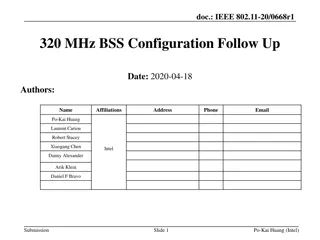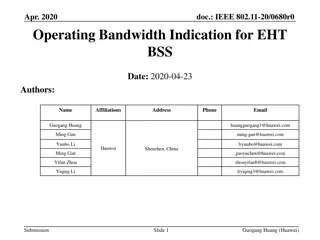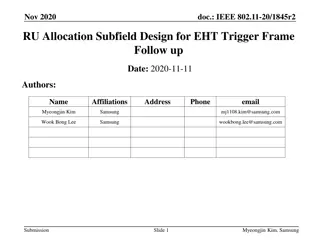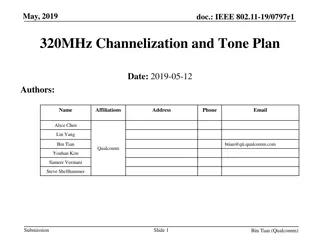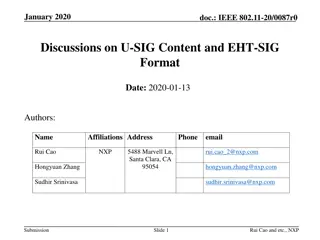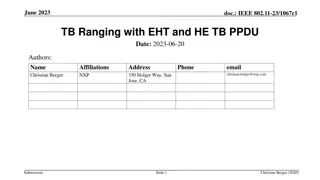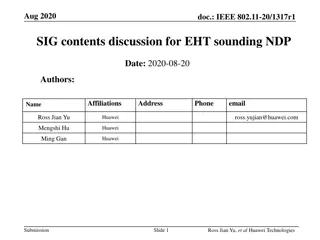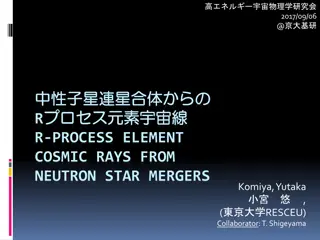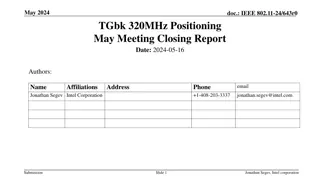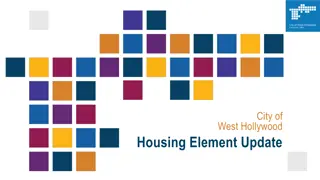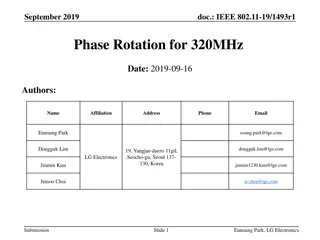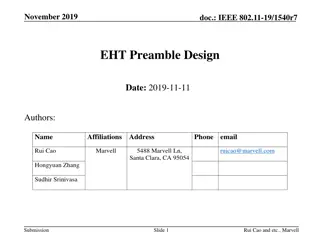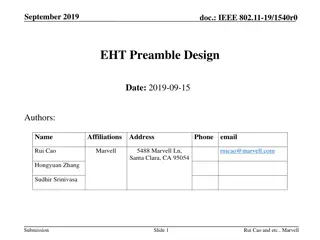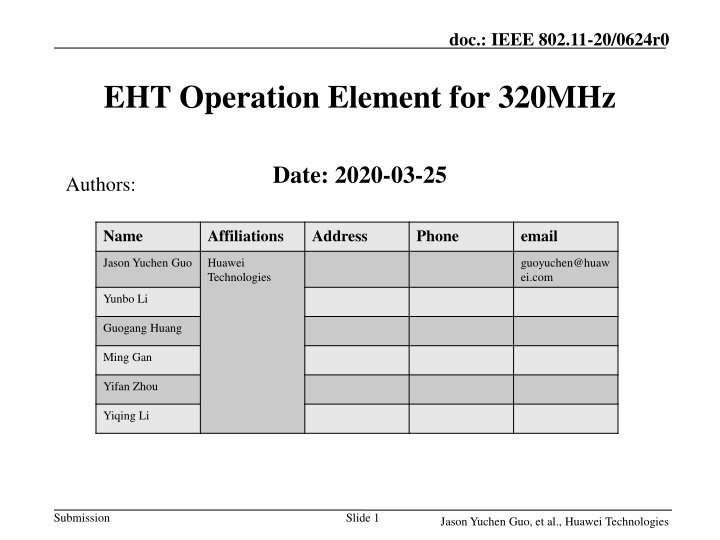
IEEE 802.11-20/0624r0 EHT Operation Element for 320MHz Development
Explore the proposal for wider bandwidth support in TGbe, including 320MHz and 240MHz, through unified signaling across multiple bands. Details on bandwidth signaling, channel widths, and parameter settings are discussed to enhance network efficiency and compatibility.
Download Presentation

Please find below an Image/Link to download the presentation.
The content on the website is provided AS IS for your information and personal use only. It may not be sold, licensed, or shared on other websites without obtaining consent from the author. If you encounter any issues during the download, it is possible that the publisher has removed the file from their server.
You are allowed to download the files provided on this website for personal or commercial use, subject to the condition that they are used lawfully. All files are the property of their respective owners.
The content on the website is provided AS IS for your information and personal use only. It may not be sold, licensed, or shared on other websites without obtaining consent from the author.
E N D
Presentation Transcript
doc.: IEEE 802.11-20/0624r0 EHT Operation Element for 320MHz Date: 2020-03-25 Authors: Name Affiliations Address Phone email Jason Yuchen Guo Huawei Technologies guoyuchen@huaw ei.com Yunbo Li Guogang Huang Ming Gan Yifan Zhou Yiqing Li Submission Slide 1 Jason Yuchen Guo, et al., Huawei Technologies
doc.: IEEE 802.11-20/0624r0 Introduction Wider bandwidth (e.g., 320MHz, 240MHz) is under development in TGbe. Current SFD: 802.11be supports 320 MHz and 160+160 MHz PPDU. 802.11be supports 240 MHz and 160+80 MHz transmission Whether 240/160+80 MHz is formed by 80 MHz channel puncturing of 320/160+160 MHz is TBD. However, even in the non-contiguous case (160+160MHz, 160+80MHz), it is sometimes difficult to find such large bandwidth in a single band. Different segments may be located in different bands E.g., one segment in 5GHz, the other segment in 6GHz In this contribution, we propose a unified signaling to support the wider bandwidth by using a single band or multiple bands. Submission Slide 2 Jason Yuchen Guo, et al., Huawei Technologies
doc.: IEEE 802.11-20/0624r0 Recap 80+80 mode in 802.11ac/ax For bandwidth signaling for the 80+80 mode, we need to indicate the following: Primary channel indicated in the HT operation element Center frequency of the two segments indicated in the VHT operation element + S20 P20 S80 S40 + 80MHz 80MHz HT operation element Submission Slide 3 Jason Yuchen Guo, et al., Huawei Technologies
doc.: IEEE 802.11-20/0624r0 Recap all possible BW indication Besides, we use Channel Width to differentiate 20/40 and 80/160/80+80 Further, we use SCO to differentiate 20MHz and 40MHz, and we use the relationship of CCFS0 and CCFS1/2 to differentiate 80MHz, 160MHz and 80+80MHz BW Parameter setting Judgment Primary channel Secondary channel offset Channel Width CCFS0 CCFS1/2 Channel center frequency index of the P20 0 (SCN) 0 (5GHz) 0 (6GHz) Channel center frequency index of the P20 0 SCO = 0 && Channel width = 0 20MHz Channel center frequency index of the P20 Set to 1 or 3 (SCA or SCB) 0 (5GHz) 1 (6GHz) Channel center frequency index of the P40 0 SCO != 0 && Channel width = 0/1 40MHz Channel center frequency index of the P20 Set to 1 or 3 (SCA or SCB) 1 (5GHz) 2 (6GHz) Channel center frequency index of the P80 0 CCFS1/2 = 0 && Channel width = 1/2 80MHz Channel center frequency index of the P20 Set to 1 or 3 (SCA or SCB) 1 (5GHz) 3 (6GHz) Channel center frequency index of the P80 Channel center frequency index of the P160 CCFS1/2 > 0 and | CCFS1/2 CCFS0 | = 8 160MHz Channel center frequency index of the P20 Set to 1 or 3 (SCA or SCB) 1 (5GHz) 3 (6GHz) Channel center frequency index of the P80 Channel center frequency index of the S80 CCFS1/2 > 0 and | CCFS1/2 CCFS0 | > 16 80+80M Hz Submission Slide 4 Jason Yuchen Guo, et al., Huawei Technologies
doc.: IEEE 802.11-20/0624r0 320MHz in EHT In EHT, we may support the following bandwidth 320MHz, 160+160MHz, 240MHz, 160+80MHz For the non-contiguous modes, different segments can be in different bands E.g., for the 160+160MHz mode, the first 160MHz segment can be in Band 1(e.g., 5GHz band), and the second segment can be in Band 2(e.g., 6GHz band) In this contribution, we propose to use EHT operation element to indicate the bandwidth and locations of different segments in the cases that different segments may be located in the same band or different band. 160MHz 160MHz 5GHz band 6GHz band Submission Slide 5 Jason Yuchen Guo, et al., Huawei Technologies
doc.: IEEE 802.11-20/0624r0 The EHT operation element Element ID Length EHT Operation Information operating class Channel Width EHT CCFS Operating class: the operating class of the secondary band A STA needs to know which band is the first band, and which band is the second band The first band is the band where the primary channel is The second band needs to be indicated by the operating class field A special value (e.g., 255) of the operating class field indicates that the second band does not exist degrade to the single- band case Channel Width A value 0 means the bandwidth is less than or equal to 160/80+80MHz A value 1 means the bandwidth is 320/160+160 A value 2 means the bandwidth is 240/160+80 EHT CCFS: In the case of contiguous 320MHz and 240MHz: indicates the center frequency In the case of non-contiguous 160+160MHz and 160+80MHz: indicates the center frequency of the secondary segment Submission Slide 6 Jason Yuchen Guo, et al., Huawei Technologies
doc.: IEEE 802.11-20/0624r0 Regulation Discussion The EU regulation defines channel access rules for a specific band (e.g., 5GHz band): Run a backoff procedure in the primary 20MHz channel Other channels can be used for transmission if PIFS idle before the backoff done of the primary 20MHz (total bandwidth is bounded by 40MHz, 80MHz, 160MHz) If the same rule is applied to 6GHz, then we need another P20 on the segment of 6GHz to use it for transmission, which means the PIFS rule can not be applied However, some other regulation body (e.g., FCC) does not have such channel access rule, which means PIFS rule can be applied across different bands. Under such situation, the unified design in the previous slide works for all the regulatory domains: If PIFS access is allowed, the operating class field in the EHT operation element indicates the band of the secondary segment If the PIFS access is not allowed, the operating class field shall be set to a predefined value (e.g., 255), which means the secondary band does not exist. Submission Slide 7 Jason Yuchen Guo, et al., Huawei Technologies
doc.: IEEE 802.11-20/0624r0 Conclusion We propose a EHT operation element which includes the following fields to support the bandwidth of 160+160 and 160+80, where the segments belong to different bands Operating class field Channel Width EHT CCFS Submission Slide 8 Jason Yuchen Guo, et al., Huawei Technologies
2018 doc.: IEEE 802.11-20/0624r0 Straw Poll 1 Do you support in the bandwidth configuration of 160+160 and 160+80, different segment can belong to different band? Submission Slide 9 Jason Yuchen Guo, et al., Huawei Technologies
2018 doc.: IEEE 802.11-20/0624r0 Straw Poll 2 Do you support to include an operating class field in the EHT operation element to indicate the secondary band that the secondary segment belongs to? Submission Slide 10 Jason Yuchen Guo, et al., Huawei Technologies
2018 doc.: IEEE 802.11-20/0624r0 Reference [1] 11-20-0384-00-00be-320-mhz-bss-configuration Submission Slide 11 Jason Yuchen Guo, et al., Huawei Technologies

